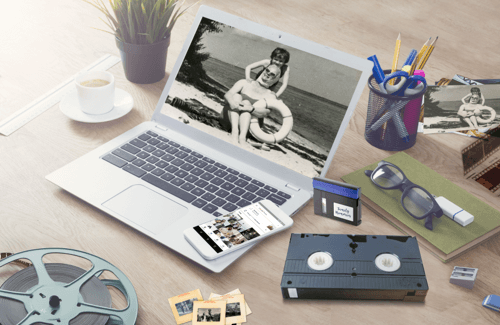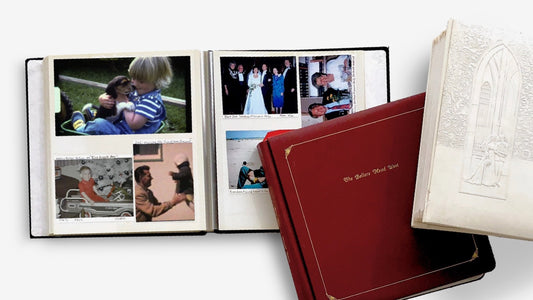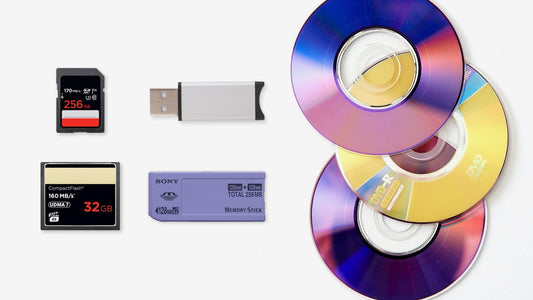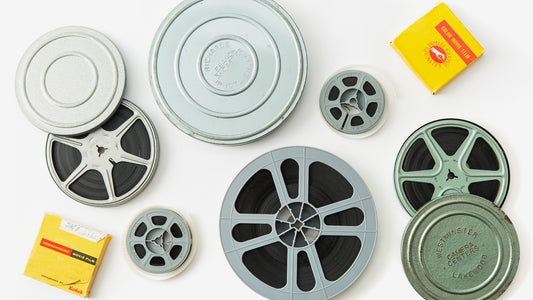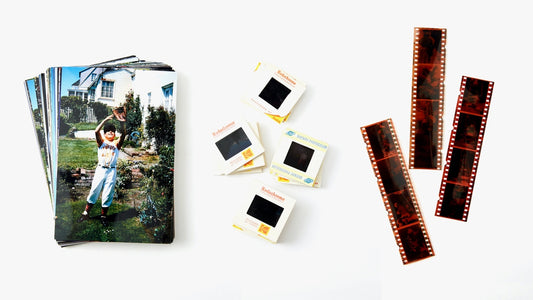That box of VHS tapes sitting in your closet or attic holds more than just magnetic tape; it holds family history. From birthday parties and holiday gatherings to a baby’s first steps, those home movies are irreplaceable. But every year they sit unused, the quality degrades, and the risk of losing those moments forever grows. The good news is that you can protect them. The process to copy vhs to digital brings those memories into the present, making them easy to watch, share, and back up. This guide will walk you through everything you need to know, from the gear required for a DIY project to the benefits of using a professional service, so you can finally give your family’s story the modern home it deserves.
Key Takeaways
- Choose Your Conversion Path: Going the DIY route gives you full control and can be cost-effective for many tapes, but it requires time and the right gear. For guaranteed quality and convenience, a professional service is the best way to protect your most important memories.
- Master the DIY Essentials: If you convert tapes yourself, your success depends on a working VCR and a quality capture device. Be prepared for a real-time process—a two-hour tape takes two hours to record—and potential tech troubleshooting.
- Preserve Quality From Start to Finish: Get the best possible transfer by inspecting your tapes beforehand and using the right capture settings. Once digitized, always save your files in a common format like MP4 and back them up in at least two places.
What You'll Need to Convert VHS to Digital
Ready to tackle your VHS conversion project? It’s a rewarding process, but you’ll need to gather a few key pieces of gear before you hit record. Think of this as your essential checklist for turning those analog memories into digital files you can easily share and enjoy. Getting your setup right from the start is the best way to ensure a smooth transfer process and protect the quality of your precious home movies. While it might seem like a lot of moving parts, the basic setup is surprisingly straightforward once you have everything in front of you. The goal is to create a simple chain: your VCR plays the tape, a capture device translates the signal, and your computer records the final digital video. This method gives you complete control over the process, from start to finish. Before you start plugging things in, take a moment to gather all the necessary components. Having everything laid out and ready to go will make the actual conversion feel less like a technical challenge and more like a fun trip down memory lane. Let's walk through exactly what you'll need to have on hand.
Your VCR or VHS Player
First things first, you absolutely need a VCR to play your tapes. This is the heart of your entire setup. If you don't have one tucked away in the attic, you might need to do a little hunting. Check local thrift stores, online marketplaces like eBay, or even ask family and friends. Before you buy, try to confirm it’s in good working condition—specifically, that it can play tapes smoothly without eating them. A well-maintained player is your best defense against damaging irreplaceable tapes during the transfer process. Look for a model with at least RCA outputs (the red, white, and yellow ports) to ensure it can connect to modern capture devices.
Choosing a Video Capture Device
This little gadget is the magic bridge between your old-school VCR and your modern computer. It’s an adapter that takes the analog video and audio signal from the VCR and converts it into a digital format your computer can understand. Popular and reliable options include devices like the Elgato Video Capture or the ClearClick Video to Digital Converter. These devices typically connect to your VCR with RCA cables on one end and plug into your computer’s USB port on the other, making the physical connection straightforward. Most capture devices are plug-and-play, which helps simplify the technical side of your project so you can focus on the memories.
Computer and Software Needs
You’ll need a computer, either a Mac or PC, with a free USB port and enough hard drive space to store your new video files. Keep in mind that video files can be quite large; an hour of footage can easily take up several gigabytes of space. Most video capture devices come with their own software, which is often the simplest option for recording. If you want more control or a free alternative, a program like OBS Studio is a powerful tool that lets you record the video feed from your capture device. Just be sure to clear out some space on your computer before you begin recording.
The Right Cables and Connections
To get the picture and sound from your VCR to the capture device, you’ll need a standard set of RCA cables—the ones with the iconic red, white, and yellow plugs. The yellow cable carries the video signal, while the red and white cables handle the right and left audio channels for stereo sound. You’ll plug one end into the 'AV OUT' or 'LINE OUT' ports on the back of your VCR and the other end into the corresponding colored input ports on your video capture device. It’s a simple connection that’s crucial for a quality transfer, so double-check that each cable is snug and in the correct port.
3 Ways to Convert VHS Tapes to Digital
Ready to bring your home movies into the modern era? There are a few solid paths you can take to digitize your VHS collection. The right one for you really comes down to your budget, how much time you have, and your comfort level with technology. You can tackle it yourself with a couple of key pieces of equipment, or you can hand your precious tapes over to a professional service that will handle everything for you. Let's walk through the three main options so you can decide which approach feels best for your memory-saving project.
The DIY Method: Using a Capture Device
If you’re comfortable with a little tech and want a cost-effective option, the DIY route using a video capture device is a great choice. You’ll need your VCR, a computer, and the capture device itself, which acts as a bridge between the two. You simply connect the VCR to the capture device with RCA cables (the red, white, and yellow ones), and then plug the device into your computer’s USB port. As your tape plays, the device converts the analog signal into a digital file. You can use free screen recording software like OBS to capture the video on your computer. This method gives you full control over the process from start to finish.
Using a VHS-to-DVD Recorder
Another hands-on approach is using a VHS-to-DVD combination player. These machines were popular for a reason—they make it incredibly simple to copy a VHS tape directly onto a blank DVD. You just pop in your tape and a recordable DVD and hit record. Once you have the movie on a DVD, you can use your computer’s disc drive to rip the video into a digital file like an MP4. This is a straightforward method if you happen to have one of these combo players already, but it does add an extra step to get the final digital file onto your computer for easy sharing and storage.
Using a Professional Service like YesVideo
If you’d rather skip the technical setup and guarantee high-quality results, a professional service is the way to go. Companies like YesVideo are experts in video transfer and have specialized equipment to get the best possible picture and sound from your aging tapes. The process is simple: you send in your VHS tapes, and their team of technicians handles the entire conversion by hand. They’ll digitize your memories and send them back to you on a thumb drive, DVD, or via a digital download. This option saves you a ton of time and removes the guesswork, making it perfect for preserving your most important family moments without any hassle.
How Much Does VHS to Digital Conversion Cost?
Figuring out the budget for your digitization project comes down to one main choice: doing it yourself or hiring a professional service. The path you choose will determine not just the total cost, but also the amount of time and effort you’ll need to invest. Both options have their own set of expenses, from buying equipment for a DIY setup to paying for expert handling and high-quality results from a service. Let's break down what you can expect to spend so you can find the right fit for your precious memories.
Breaking Down the Cost of DIY
If you decide to convert your VHS tapes at home, you’ll need to purchase some gear. The biggest variable is the VCR—if you don't have a reliable one stashed away, you'll have to find one. Beyond that, you'll need a video capture device to connect the VCR to your computer, which can cost anywhere from $40 to over $100. Add in the necessary cables, and you’re likely looking at a starting investment of around $100 to $200. While this might seem cheaper for a large collection, remember to factor in your time, as the process can take hours for each tape.
Comparing Professional Service Prices
Opting for a professional service means you're paying for convenience, expertise, and high-quality equipment you don't have to buy yourself. Prices can vary, but most services charge on a per-tape basis, generally between $15 and $40 per tape. Some companies have different pricing tiers based on the length of the tape, while others offer a flat rate. These services, like our video transfer process, handle everything from cleaning and playback to digitizing and providing you with a final digital copy, saving you a ton of time and technical headaches.
A Look at the Cost Per Tape
When you look at the cost per tape, it’s important to see what’s included. At YesVideo, we simplify the process with a clear pricing model. For one flat fee per tape, we digitize the entire contents, regardless of its length. This price includes our team carefully processing your memories by hand, right here in the USA. You receive a digital copy you can download from the cloud, with options to add a USB or DVD. This straightforward approach ensures there are no surprise fees, giving you peace of mind and a predictable budget for preserving your entire collection.
The Best Brands for VHS Conversion Gear
If you’ve decided to take on the project of converting your VHS tapes yourself, picking the right gear is your most important first step. The quality of your equipment will directly impact the quality of your final digital videos. Think of it as a three-part system: a reliable VCR to play the tape, a capture device to act as a bridge to your computer, and software to record and save the digital file.
Getting this combination right can be tricky, as it involves finding older technology that still works well and pairing it with modern computers. You’ll want to look for brands known for their reliability and ease of use to make the process as smooth as possible. Investing in decent gear can save you from the frustration of poor-quality transfers, dropped frames, or, even worse, a damaged tape. It’s a project that requires patience and a bit of technical know-how, but with the right tools, you can create digital copies of your family’s memories.
Top USB Capture Devices
A video capture device is a small but mighty tool that translates the analog signal from your VCR into a digital format your computer can understand. One of the most recommended options is the Elgato Video Capture, which is widely praised for its high-quality transfers and straightforward software. It’s a great choice if your main goal is a clean, reliable digital copy. Another popular device is the Roxio Easy VHS to DVD, which lives up to its name with a simplified design that makes transferring footage easy. It connects your VCR to your computer through simple RCA or S-video cables and gets the job done with minimal fuss.
Reliable VCRs and Players
Your VCR is the starting point for your entire project, and its condition is critical. A dusty, poorly maintained VCR won’t just produce a fuzzy picture—it can chew up or permanently damage your irreplaceable tapes. Since new VCRs are no longer manufactured, you’ll likely be looking for a used one online or at a thrift store. When you find one, look for a model with an S-Video output, as this connection typically offers better video quality than the standard yellow RCA cable. Before you put your precious home movies in it, be sure to thoroughly clean the VCR’s heads with a head-cleaning tape or isopropyl alcohol to ensure the best possible playback.
Recommended Conversion Software
The final piece of the puzzle is the software that will capture and save your video. Some capture devices, like the Roxio, come with their own software, which is often the easiest route. If you need a separate program, a tool like Golden Videos is designed specifically to help you convert tapes into common digital formats like AVI or MPEG. Once you’ve captured the footage, remember to choose a file format that’s easy to share, like MP4. And don’t forget the most important final step: backing up your new digital files. Create at least one copy on an external hard drive or cloud service to ensure your memories are safe for years to come.
Common Challenges When Converting VHS Tapes
Converting VHS tapes yourself can be a rewarding project, but it often comes with a few hurdles. Getting old and new technology to cooperate requires patience, and the tapes themselves can be fragile after decades in storage. Understanding these common challenges ahead of time can help you decide on the best approach for your precious home movies and ensure they come out looking their best. From technical glitches to the sheer time involved, being prepared is the key to a successful conversion project.
Dealing with Tech and Compatibility
One of the first challenges you'll face is the hardware itself. Finding a VCR that’s still in good working condition can be tough, and even if you have one, it might not be ready to use. A dusty or poorly maintained VCR can easily scratch or even eat a delicate tape, causing permanent damage to your memories. Beyond the VCR, you’ll need to make sure your video capture device is compatible with your computer and its operating system. It’s common to run into issues with software drivers and connections, which can stop your project before it even starts.
The Time Commitment
Digitizing tapes isn't a quick process. The conversion happens in real-time, which means if a tape is two hours long, it will take at least two hours to capture it on your computer. Now, multiply that by the number of tapes you have. A small box of 10 tapes could easily add up to 20 or 30 hours of recording time alone. This doesn’t include the time for setting up your equipment, troubleshooting any connection problems, or editing the final video files. It’s a significant time investment that requires you to monitor the process from start to finish.
What to Do with Damaged Tapes
Over the years, VHS tapes can degrade in storage. Before you press play, it’s crucial to inspect each one for damage. Look for signs of mold, which often appears as white or black spots on the tape itself. Also, check for warping of the cassette shell or a sticky residue on the film, which can cause playback errors. Playing a damaged tape can not only ruin the recording but also harm your VCR. If you find tapes that are in rough shape, it’s often best to let professionals handle them. A professional video transfer service has the specialized equipment to clean and repair tapes safely.
Choosing Your File Format and Storage
Once your video is captured, the work isn’t quite done. You need to choose the right file format to save it in. Formats like MP4 are great because they are widely compatible with most devices and offer a good balance of quality and file size. Choosing the wrong format could leave you with massive files that are hard to store or share. Speaking of storage, one of the biggest mistakes is not backing up your new digital files properly. Always save your digitized memories in at least two places, like a cloud service and an external hard drive, to protect them from being lost.
How to Get the Best Quality from Your VHS Tapes
Getting a clear digital copy from a decades-old VHS tape can feel like a bit of an art form. The final quality depends on the condition of your original tape, the VCR you use, and the settings you choose for the conversion. While you can't magically turn a grainy home movie into a 4K masterpiece, you can take several steps to ensure you get the best possible version of your precious memories. Think of it as restoring a classic photo—the goal is to preserve its original charm while cleaning up the noise. By paying close attention to your tapes and equipment, you can avoid common pitfalls and create a digital archive you’ll be proud to share.
Prep and Clean Your Tapes
Before you press play, take a moment to inspect your tapes. After years in storage, they can accumulate dust, debris, or even mold. Playing a dirty or damaged tape can lead to a poor-quality transfer and, even worse, can damage your VCR's heads. Look for any visible signs of mold, warping of the plastic casing, or a sticky residue on the tape itself. If a tape looks compromised, it’s often best to let an expert handle it. For tapes that are just a bit dusty, you can gently wipe the cassette with a soft, lint-free cloth. Don’t try to clean the magnetic tape ribbon yourself, as it’s incredibly delicate and easily ruined. For truly precious or damaged memories, a professional video transfer service has the specialized equipment to safely clean and digitize them.
Choosing the Right Capture Settings
Once your tape is ready, your software settings are the next critical step. One of the most common mistakes is choosing the wrong file format. You'll want a format that balances quality with file size and is easy to share. MP4 is the universal standard and a great choice for compatibility across devices, from your phone to your smart TV. When it comes to resolution, remember that VHS is a low-resolution format. Capturing in high definition won't add detail that isn't there; it will just create a massive file. Stick to a standard definition setting (like 640x480 or 720x480) to get a file that accurately reflects the source without taking up unnecessary space.
Troubleshooting Your Connection
A stable physical connection between your VCR, capture device, and computer is essential for a smooth transfer. A loose cable can cause flickering, static, or a complete loss of signal mid-recording. Before you start, double-check that every cable is plugged in securely. It’s also vital to use clean equipment. A VCR with dusty or dirty heads can introduce static and lines into your video and can even scratch your tapes. If you plan on digitizing a large collection, it’s worth investing in a VCR head cleaner tape and running it through the player before you begin. A clean signal path is your best bet for a clean digital copy.
Solving Common Quality Issues
Even with perfect prep, you might run into some quality issues. Wavy lines at the top or bottom of the screen are often a sign of tracking problems. Most VCRs have a tracking adjustment button on the remote or the unit itself that can help clear this up. If the audio is humming, try plugging the VCR and your computer into the same power strip to resolve potential grounding issues. Finally, once your video is digitized, ensure its long-term quality by making it accessible and safe. A common oversight is forgetting to back up the files. Save your new digital memories in at least two places, like a cloud service and an external hard drive. Professional services handle all of this, delivering digital media transfers that are easy to share and securely stored.
DIY or Professional Service: Which Is Right for You?
Deciding how to convert your VHS tapes really comes down to your comfort with technology, your budget, and how much time you have on your hands. Both the do-it-yourself approach and professional services have their own advantages. The best choice is the one that fits your specific situation and helps you finally get those precious memories into a format you can easily watch and share. Let’s walk through the key factors to help you decide which path is right for you.
When to Go the DIY Route
If you’re tech-savvy and already have a working VCR, the DIY method can be a rewarding and cost-effective project. To get started, you’ll need your VCR to play the tapes and a special piece of hardware called a video capture device to convert the analog signal to a digital file. These devices connect your VCR to your computer, allowing you to record the playback as an MP4 or another digital format. This approach can be cheaper if you have a large collection of tapes to get through, but it does require a bit of setup and a willingness to troubleshoot any technical hiccups along the way.
The Perks of a Professional Service
For those who value convenience or don’t want to spend time sourcing old equipment, a professional service is the perfect solution. Instead of wrestling with cables and software, you simply send your tapes to a team of experts who handle the entire process for you. Companies that specialize in video transfer use professional-grade equipment to ensure the highest possible quality from your aging tapes. This option saves you a significant amount of time and gives you peace of mind knowing your irreplaceable memories are being handled by experienced technicians. It’s an excellent choice for anyone who wants guaranteed results without the hassle.
Comparing Quality, Convenience, and Time
When you weigh your options, the trade-offs become clear. The DIY route requires a real time investment—you have to convert each tape in real-time, which means a two-hour tape takes two hours to capture, not including setup. While it can be more affordable for dozens of tapes, a professional service is often more economical for smaller batches. More importantly, a professional service provides a level of quality and consistency that can be difficult to achieve at home. They handle everything from cleaning the tapes to optimizing the digital files, ensuring your home movies look their best for years to come.
Start Your VHS Conversion Project
Getting started is often the hardest part, but converting your VHS tapes is a rewarding process that brings old memories back to life. Breaking the project into a few manageable steps makes it much easier. It all begins with a clear plan, the right setup, and a strategy for keeping your newly digitized videos safe for years to come.
Plan Your Approach
Your first decision is how you want to tackle the conversion. You have two main paths: the do-it-yourself (DIY) route or using a professional service. The DIY method involves buying your own equipment and handling the transfer yourself. This gives you complete control, but it requires some technical know-how and time. On the other hand, a professional video transfer service handles everything for you. You simply send in your tapes, and experts create quality digital files, which is perfect if you're short on time or want to ensure the best results.
Set Up Your Workspace
If you decide to go the DIY route, you’ll need to set up a dedicated space. First, you'll need a functioning VCR to play your tapes. The next key piece of equipment is a video capture device, which acts as a bridge between your VCR and your computer. This small gadget converts the analog signal from the VHS tape into a digital file that your computer can save. You’ll connect the VCR to the capture device, and the capture device to your computer, usually via a USB port.
Organize and Back Up Your New Digital Files
Once you’ve converted your tapes, the final step is to organize and protect your new digital memories. Video files can take up a lot of storage space, so you’ll need a plan. An external hard drive is a great option for keeping all your files in one place. You might also consider using a cloud storage service to access your videos from anywhere. Most importantly, always create at least one backup copy. Storing your files in two separate places—like on a hard drive and in the cloud—ensures your memories are safe from accidental deletion or device failure.
Related Articles
- How to Change VHS to Digital: The Ultimate Guide – YesVideo
- Best VHS Video to Digital Converters: Top Picks – YesVideo
Frequently Asked Questions
What if my tapes look moldy or damaged? Can I still convert them? If you see any signs of damage, like a cracked case, a tangled ribbon, or white, spotty mold, it's best to stop and not put the tape in your VCR. Playing a compromised tape can permanently ruin the recording and can also damage your player. This is a situation where a professional service is your safest bet, as they have specialized equipment to safely clean and repair tapes before the transfer process.
How much time does it really take to convert one tape myself? The conversion process happens in real-time, which means a two-hour tape will take two hours to record onto your computer. That doesn't include the time for setting up your equipment, troubleshooting any connection issues, or organizing and backing up the final digital file. For a small collection, be prepared to set aside a full weekend for the project.
If I use a professional service, will I get my original VHS tapes back? Yes, absolutely. Reputable services understand that your original tapes are irreplaceable. The process involves carefully digitizing the content from your tapes and then securely packing and returning the originals to you along with your new digital copies. You don't have to choose between the old and the new.
Can the conversion process make my old, grainy home movies look like HD video? The goal of VHS conversion is preservation, not enhancement. A high-quality transfer will create a digital file that is a faithful representation of what’s on the tape, but it can't add detail that was never there to begin with. Think of it as getting the best possible version of the original, preventing it from degrading any further.
What’s the single most important piece of gear for a DIY project? While the capture device gets a lot of attention, your VCR is the true foundation of your project. A well-maintained player with clean heads is essential for getting a clear picture and stable audio. Using a dusty, old VCR that hasn't been used in years is the quickest way to get a poor-quality transfer or, even worse, damage your precious tapes.





